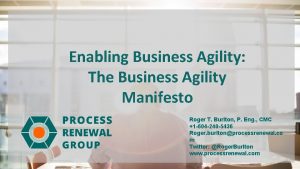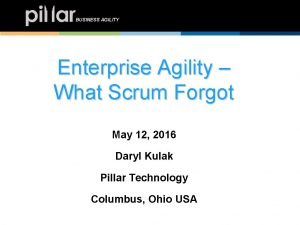Introduction to Agility is a comprehensive response to





- Slides: 5

Introduction to Agility is a comprehensive response to the business challenges of profiting from rapidly changing, continually fragmenting, global markets for high-quality, high-performance, customer-configured goods and services Agility is the ability to both create and respond to change in order to profit in a turbulent business environment Agile projects are not controlled by conformance to plan but by conformance to business value Agility is a way of life, a constantly emerging and changing response to business turbulence project success = business success TM

Software Development Landscape n From the well-known Standish CHAOS Report 1994 n n n Software projects fail: l Cancelled - 31%; Late or lacking of features – 53% Industry has only delivered on-time and on-budget 16% of the time! In 1995, this cost American companies well over $150 billion 94 of 100 projects will have restarts Average cost overrun is 189% 3 top reasons for failure l Lack of user (sponsor) involvement l No executive management support l Unclear, incomplete, & changing requirements Typical software project experiences a 25% change in requirements n 45% of features defined in early specs are never used n project success = business success TM

Bridge to Success The Standish Group concluded that keys to success are: n n n n Shorter time frames Delivery of software components early and often Iterative process “Growing" software vs. "developing" software Engage the user earlier Clear statement and set of objectives for components Keep it simple! - Complexity = confusion and cost project success = business success TM

Three Flawed Assumptions n It is actually possible to plan a large project well enough that success is primarily determined by degree of conformance to plan n It is possible to protect against late changes to a large system project n It make sense to lock in big project decisions early project success = business success TM

Scrum Process Key Practices n Self-directed; self-organizing teams n 15 minute daily stand up meeting with 3 special questions n 30 -calendar day iterations n Each iteration begins with adaptive planning n Stakeholder demo at end of each iteration n Team measures progress daily n Each iteration delivers tested, fully-functional software n Never more than 30 -days from potential production release project success = business success TM









